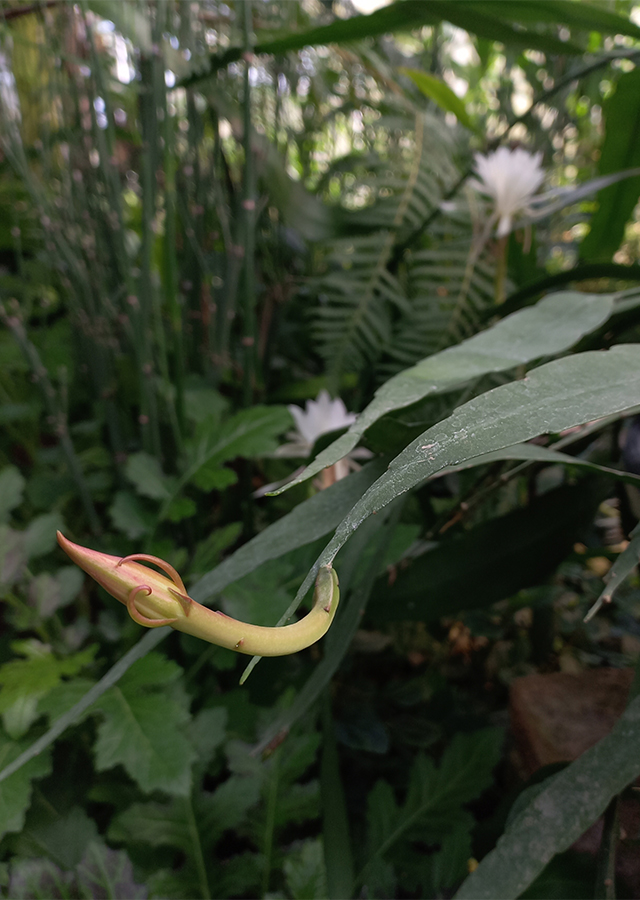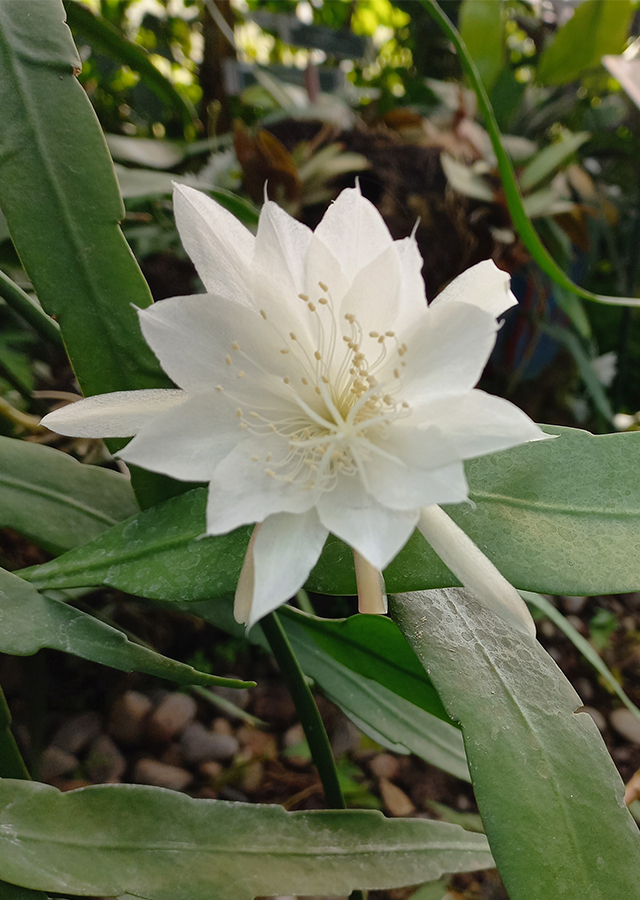Traditional Herbs from Epiphyllum phyllanthus
accelerate_healing_t_b_c_tuberculosis
- Prepare 3-5\u00a0wijaya kusuma flowers, 75 g\u00a0aloe vera gel, 15 g\u00a0sugar, 800 ml water.
- Boil all the ingredients until they boil and feel cooked.
- Strain then drink it while it's warm.
- Drink this boiled water regularly every day to get results best.
What is Epiphyllum phyllanthus Looks like??



Parts of Epiphyllum phyllanthus that could be used
- Flower
- Stem
Epiphyllum phyllanthus Distribution
Epiphyllum phyllanthus is a flowering succulent plant from the Cactaceae family that is widespread in South America, stretching from southern Mexico to Paraguay, Northwest Argentina and southern Brazil. This species is widely grown as an ornamental plant and is native to Mexico. In Indonesia, this species is often considered a plant with a mystical smell. In Javanese mythology, this flowering plant is considered 'magical' and is able to bring the dead to life. This species is generally taken from nature to be used as food and medicine. Where, E. phyllanthus fruit can be consumed raw. The fruit has delicious, slimy flesh with a slightly sweet taste. Apart from that, based on its function as a medicine, E. phyllanthus has also been used by the community in traditional medicine and is believed to have good health benefits.Agroecology of Epiphyllum phyllanthus
Epiphyllum phyllanthus is usually found growing mainly in seasonally dry tropical biomes and in humid or wet forests as an epiphyte. Grows near sea level to at least 1,300 m above sea level. E. phyllanthus can grow in full sun, but can thrive in partial shade. Extra light in early spring will stimulate buds. E. phyllanthus prefers environmental conditions with nighttime temperatures no cooler than 12 °C, especially in winter, and can tolerate temperatures up to 45 °C, and short periods of frost, but prolonged cold will damage or kill the plant. E. phyllanthus can usually live in a wide range of soil types, but due to its epiphytic nature, it is recommended that the plant be grown in a well-drained soil mix consisting mostly of organic matter, such as peat or sphagnum moss. E. phyllanthus can also live in soil with a pH of 5.0 to 9. However, this species prefers soil with a higher alkaline pH of 6.2 to 7.0. E. phyllanthus can survive moderate to high humidity levels. In fact, this species requires moderate to high humidity for growth.
Morphology of Epiphyllum phyllanthus
- Primary stem elongated round, transverse terete or angular/3-winged below 50-100 cm or more long, often branched, then flat or thin (like leaves) 100 cm long. Secondary stem arises from the flat part of the primary stem, round across to three corners at the base, then flat and linear with a length of about 25-50 cm and a width of 3-10 cm, green with a very clear purple border, stiff to flexible, with a prominent midrib, the edges are slightly lobed and toothed, the teeth are blunt. On the stem there are aerial roots.
- No leaves.
- Areoles are small, located along the edges of the branches which are sometimes hairy, usually only cream-colored wool. .
- Scented flowers, up to 30 cm long, located on the edge of the flat part of the stem. The slender perianth tube is much longer than the branches/branches, straight on the upright stem, and strongly curved on the hanging greenish-yellow perianth segments colored red, while the narrow inner perianth segment is 2.5-10 mm wide, white to cream in color. The scales on the flower tube are few, spread out. The anthers (filaments) are short and white while the anthers (anthers) are light brown. The pistil (style) is long, slender, pink or white. Stigma-lobes about 10 short, white. The flowers open at night (nocturnal) and have a strong aroma that is emitted at night. Blooming lasts only for a short time, 1 night.
- The fruit is pink-purple when ripe, has white flesh, is slimy and tastes sweet.
- The seeds are large, black, and numerous.
Cultivation of Epiphyllum phyllanthus
- Plant propagation is mostly done through leaf-like stem cuttings or through seeds (rare) in spring.
- Seeds should be sown in a well-drained seedling medium and can germinate in 14 to 28 days at a temperature of 18 to 21\u00b0C .
- Through cuttings, cut leaf-like stems 15 - 23 cm (6 - 9 inches) long and leave the callus (dry) for several days in place warm. Fill the pot one third full with compost and cover with a layer of sand. Insert the cuttings 3-5 cm deep. Keep the compost moist and maintain a temperature of 18 - 24 \u00b0C. The plant can root in three to six weeks next.
- Wijaya kusuma plants easily shed their buds if moved. Therefore, after the flower buds form, do not move the plant, because a slight change in the environment can cause the buds to fall off.
Epiphyllum phyllanthus, more details :
Chemical Content of Epiphyllum phyllanthusInformation not found. Need further investigation.
Benefits of Epiphyllum phyllanthus
Treats broken bones, rheumatism, accelerates healing of tuberculosis (tuberculosis), whooping cough, coughs and colds, back pain, and acts as a laxative.
Simplisia of Epiphyllum phyllanthus
Another Facts for Epiphyllum phyllanthus :
Synonym of Epiphyllum phyllanthusCactus phyllanthus L., Cereus phyllantus (L.) DC., Opuntia phyllanthus (L.) Mill.
Habitus of Epiphyllum phyllanthus
Succulents. Succulent, annual (perennial), epiphyte
Habitat of Epiphyllum phyllanthus
- Forest
- Land
No comments:
Post a Comment